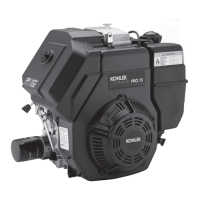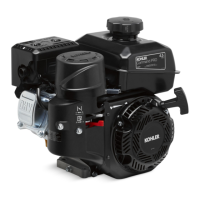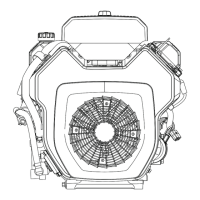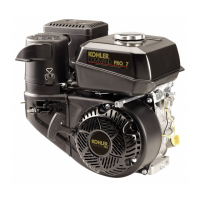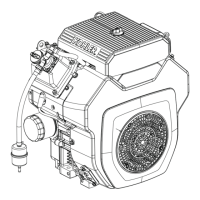6.2
Section 6
Lubrication System
Check Oil Level
The importance of checking and maintaining
the proper oil level in the crankcase cannot be
overemphasized. Check oil BEFORE EACH USE as
follows:
1. Make sure the engine is stopped, level, and is
cool so the oil has had time to drain into the
sump.
2. Clean the area around and beneath the dipstick
or the oil fi ll plug before removing it. This will
help keep dirt, debris, and other foreign ma er
out of the engine. See Figure 6-3.
Oil Drain
Plug
Oil Drain
Plug
Oil Fill
Plug
Dipstick
Oil Fill
Plug
Dipstick
3. Checking oil level with a dipstick. Unscrew and
remove the dipstick; wipe off oil. Reinsert the
dipstick into the oil fi ll tube and rest the dipstick
on the oil fi ll tube. Turn it counterclockwise until
the cap drops down to the lowest point of the
thread leads. Do not thread the dipstick cap into
the tube. See Figure 6-5.
Dipstick
Low Oil
Level
Upper
Oil Level
Oil Fill Neck
(Bottom Edge)
Engine Oil
Oil Fill Neck
(Bottom Edge)
Upper
Oil Level
Oil Fill
Plug
Engine Oil
Figure 6-3. Location of Dipstick, Oil Fill Plug, and
Oil Drain Plugs.
NOTE: The engine may be equipped with two
dipsticks or an oil fi ll plug and a dipstick.
These can be placed in either hole. See
Figure 6-4.
Figure 6-4. Location of Dipstick and Oil Fill Plug.
Figure 6-5. Dipstick Oil Level Check.
Checking oil level with an oil fi ll plug. Unscrew
and remove the oil fi ll plug. The level should be
up to but not over, the point of overfl owing the
fi ller neck. See Figure 6-6.
Figure 6-6. Oil Fill Plug Oil Level Check.
4. If the level is low, add oil of the proper type
(Refer to Oil Type) to the correct level. Always
check the level before adding more oil. See
Figures 6-5 and 6-6.
NOTE: To prevent extensive engine wear or
damage, always maintain the proper oil
level in the crankcase. Never operate the
engine with the oil level above or below
the correct level.
